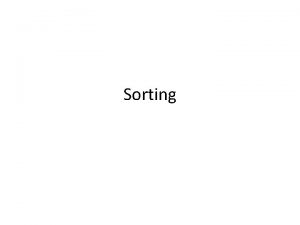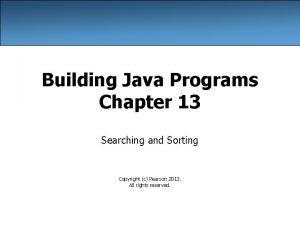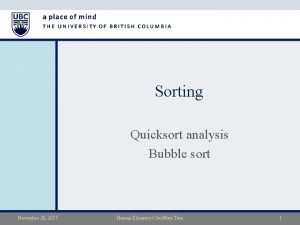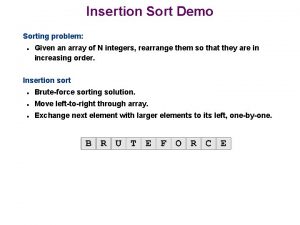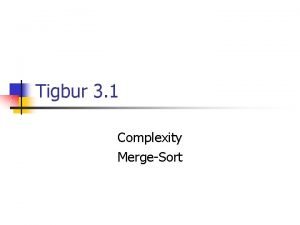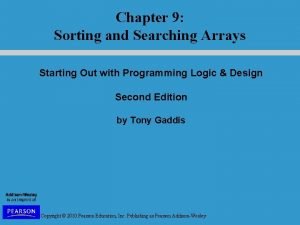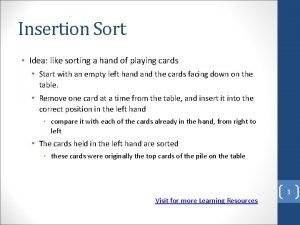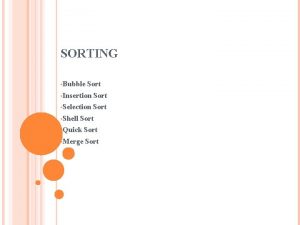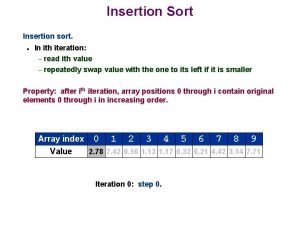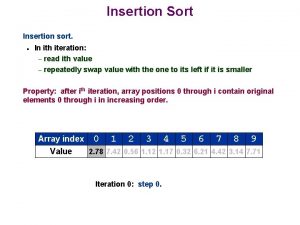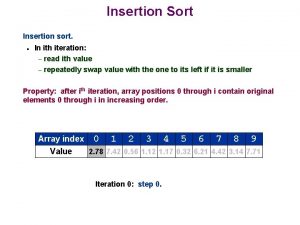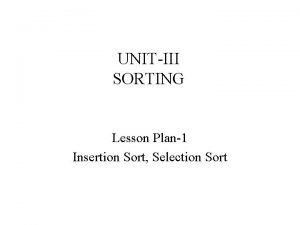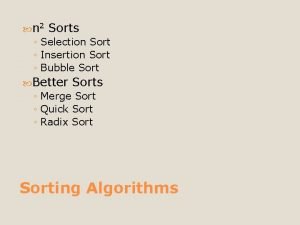Lecture 25 Selection sort reviewed Insertion sort reviewed






![Details for sort public static void sort(int left, int right, double[] x, double[] temp){ Details for sort public static void sort(int left, int right, double[] x, double[] temp){](https://slidetodoc.com/presentation_image_h2/d6516ea8a2394dc09f747377b63b67a3/image-7.jpg)












- Slides: 19

Lecture 25 • • Selection sort, reviewed Insertion sort, reviewed Merge sort Running time of merge sort, 2 ways to look at it • Quicksort • Course evaluations

Selection sort • for k = 1 to n-1 – find kth smallest item – swap it with the one in the kth position • number of comparisons – – n-1 for k=1 n-2 for k=2 … 1 for k=n-1 • total: n(n-1)/2

Insertion sort • for k=2 to n – move kth item into sorted order with respect to the first k-1 items which already sorted – involves moving sorted items over: can do this at the same time as finding where kth item has to go • number of comparisons: worst case – – 1 for k=2 2 for k=3 … n-1 for k=n • total: n(n-1)/2 • on average, maybe n(n-1)/4, but involves more moving of data than selection sort

Bubble sort • Pass through data, swapping neighbors that are out of order • After first pass, largest element has “sunk” to bottom • Repeat until no more swaps are needed, considering one less pair each time • Cost: n-1 comparisons for first pass, n-2 for 2 nd pass, etc. • May need n-1 passes, so also “O(n 2)”

Merge sort • • • Recursive If only one item, return Sort first half by merge sort Sort second half by merge sort Merge the results

Keys to efficiency • Recursion: reduce problem to two problems of half the size • Also known as: divide and conquer • Merge step: only requires n comparisons, where n is number of items to be merged • Need two arrays, but no more • Do not construct arrays inside the recursive call!!! (The comprehensive edition of Liang does this) • How should we implement this in Java? • public static sort(what parameters? ) • We cannot pass “half an array”, so what to do?
![Details for sort public static void sortint left int right double x double temp Details for sort public static void sort(int left, int right, double[] x, double[] temp){](https://slidetodoc.com/presentation_image_h2/d6516ea8a2394dc09f747377b63b67a3/image-7.jpg)
Details for sort public static void sort(int left, int right, double[] x, double[] temp){ if(left == right){ return; } int mid = (left+right)/2; sort(left, mid, x, temp); // sort first half of x using temp sort(mid+1, right, x, temp); // sort second half of x using temp merge(left, mid, right, x, temp); // merge them into temp copy(left, right, temp, x); // copy temp back to x }

Details for merge(left, mid, right, x, temp) • • Keep 3 ints: i, j, k i initialized to left j initialized to mid+1 k initialized to left advance until i > mid or j > right copy the rest of one of the other half cute trick: 2 additional while loops another trick: do nothing if x[mid] <= x[mid+1] • for this reason, better move the copy inside merge

Number of comparisons • Let C(n) = number of comparisons to sort array of length n by merge sort • Clearly, C(n) = 2 C(n/2) + (n-1), if n is even, > 0 • or a little less, if we program merge efficiently • C(1) = 0 • C(2) = 1 • C(4) = 5 • C(8) = 17 • C(16) = 49 • Hard to see a pattern, but when we double n, the number of comparisons is also doubled, + an extra n 1 comparisons

Let’s simplify this slightly • • Count the merge as n comparisons, instead of n-1 C(n) = 2 C(n/2) + n, if n is even, > 0 C(1) = 0 C(2) = 2 C(4) = 8 C(8) = 24 C(16) = 64 Do you see a pattern now? Assume n is a power of 2, say 2 k • By inspection, C(n) = k n • In other words, C(n) = n log 2(n)

Proof by induction on k • Base case: C(1) = 1 log 2(1) = 0 • Inductive hypothesis: suppose true for k-1: C(2 k-1) = (k-1) 2 k-1 • Just like: assume the recursive magic works • Want to prove true for n=k • C(2 k) = 2 C(2 k-1) + 2 k • = 2 (k-1) 2 k-1 + 2 k • = (k-1) 2 k + 2 k • = k 2 k

Proof that all horses have same color • proof by induction on number of horses • if n=1, true • inductive hypothesis: suppose true for n-1: if you have n-1 horses, they are all same color • given n horses in a corral, take 1 out: rest must have same color • put it back and take a different one out: rest must have same color • therefore they are all the same color • what is wrong with this?

An easier way to think about merge sort • • 1 call to sort array of length n 2 calls to sort array of length n/2 4 calls to sort array of length n/4 8 calls to sort array of length n/8 … n calls to sort array of length 1 at each level, the merge operations take a total of at most n comparisons • since the number of levels is log 2 n the total number of comparisons is at most n log 2 n

What if n is not a power of 2? • Does not really matter: mid = (left + right)/2 rounds down which is fine • Number of comparisons is still approximately n log 2 n (which is not an integer) • We say running time is O(n log 2 n) • Base of logarithm doesn’t matter much, because log 10 n = log 2 n/log 210

Quicksort • Similar recursive idea, but avoids the need for 2 arrays • Chooses a pivot element, then divides array into two parts, one with elements ≤ pivot, and one with elements > pivot • Possible ways to choose pivot: see next page • To partition the array, loop from left to find first element > pivot, and loop from right to find first element <= pivot • Swap them and repeat • Place pivot in right place • Make two recursive calls

How to choose the pivot • Goal: want to choose pivot to divide array approximately in half, but want to do this fast • Ideas? • First position • middle position • average value • median value • randomly chosen • median of items in first, middle and last positions

Number of comparisons for quicksort • Assuming arrays divided approximately in half each time, same as merge sort • Advantage: only one array • Disadvantage: items with equal values may end up interchanged from their original value • Doesn’t matter for primitive types, but may matter for objects • For this reason the Arrays. sort methods use quicksort for primitive types and merge sort for Comparable objects

Other sorts • Heapsort: slightly slower than quicksort on average but number of comparisons is n log 2 n even in worst case, like merge sort • Radix sort

Big O Notation • We say a function f(n) is O(g(n)) if there is a constant c so that f(n) ≤ c g(n) for all n • Thus we say the number of comparisons for merge sort is O(n log n) • We don’t need to write the base • Which of these functions are O of the others: • log n, 2 n, 10 n , n 2, n 3, n, n log n
 Bubble sort vs selection sort
Bubble sort vs selection sort Difference between insertion sort and bubble sort
Difference between insertion sort and bubble sort Nnn sort
Nnn sort Difference between selection and insertion sort
Difference between selection and insertion sort Heap sort vs quick sort
Heap sort vs quick sort Bubble sort vs selection sort
Bubble sort vs selection sort Bubble sort vs selection sort
Bubble sort vs selection sort Bubblesort pseudocode
Bubblesort pseudocode Foo9822
Foo9822 Goutresolved reviewed
Goutresolved reviewed Insertion sort flow chart
Insertion sort flow chart Insertion sort demo
Insertion sort demo Knuth shell sort
Knuth shell sort Insertion sort bbc bitesize
Insertion sort bbc bitesize Selection sort mips
Selection sort mips Recurrence relation of bubble sort
Recurrence relation of bubble sort Sorting defination
Sorting defination Insertion sort flowchart in c
Insertion sort flowchart in c Dfs algorithm
Dfs algorithm Insertion of idea
Insertion of idea

